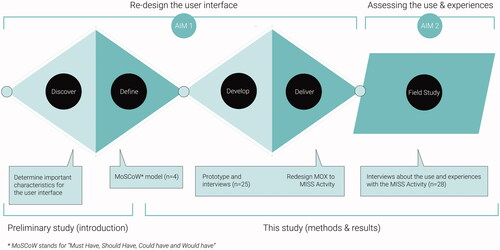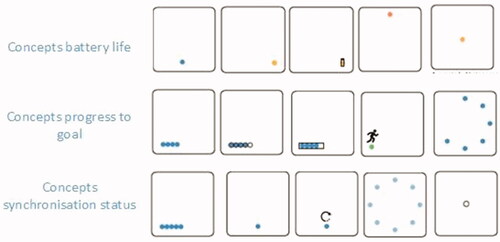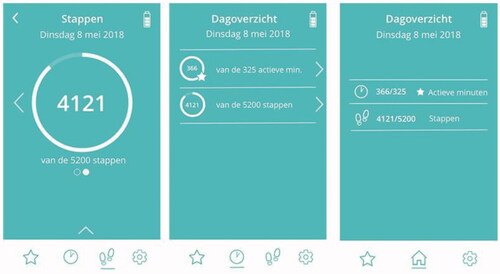Abstract
Purpose
The purposes of this study were, first, to (re)design the user-interface of the activity tracker known as the MOX with the help of input from elderly individuals living independently and, second, to assess the use of and experiences with the adapted Measure It Super Simple (MISS) activity tracker in daily life.
Methods
The double diamond method, which was used to (re)design the user-interface, consists of four phases: discover, define, develop, and deliver. As a departure point, this study used a list of general design requirements that facilitate the development of technology for the elderly. Usage and experiences were assessed through interviews after elderly individuals had used the activity tracker for 2 weeks.
Results
In co-creation with thirty-five elderly individuals (65 to 89-years-old) the design, feedback system, and application were further developed into a user-friendly interface: the Measure It Super Simple (MISS) activity. Twenty-eight elderly individuals (65 to 78-years-old) reported that they found the MISS activity easy to use, needed limited help when setting the tracker up, and required limited assistance when using it during their daily lives.
Conclusions
This study offers a generic structured methodology and a list of design requirements to adapt the interface of an existing activity tracker consistent with the skills and needs of the elderly. The MISS activity seemed to be successfully (re)designed, like the elderly who participated in this pilot study reported that anyone should be able to use it.
This study provides an overview of important characteristics of the activity tracker interface for elderly individuals that can be used when choosing an appropriate activity tracker.
This study can serve as a model that demonstrates how to adapt other eHealth and mHealth tools to improve the user-centred design.
The MISS activity seems to be an elderly-friendly activity tracker that can facilitate a meaningful experience.
IMPLICATIONS FOR REHABILITATION
Introduction
Smart health has become increasingly popular in recent years as a method of monitoring physical activity, as well as health- and lifestyle-related variables [Citation1]. The term smart health refers to mobile applications (apps), wearables, and smartwatches [Citation1]. Although activity trackers are mainly used by a young and physically fit population, the elderly could also benefit from the use of an activity tracker. In the Netherlands, 53% of elderly individuals (65+) do not meet the Dutch physical activity guideline [Citation2,Citation3] even though there is ample evidence that sufficient physical activity can prevent several chronic diseases, reduce the risk of premature death, and decrease the risk of fractures and falls in the elderly [Citation4,Citation5]. Barriers that inhibit elderly individuals’ physical activity noted in the literature include a lack of motivation and self-discipline, the assumption that they are already sufficiently active, limited knowledge about the positive effects of physical activity, and a lack of habits [Citation6,Citation7]. Studies show that incorporating the use of an activity tracker into one’s healthcare can motivate elderly individuals to become more physically active. The primary explanations for this phenomenon are that trackers provide insight into an elderly individual’s amount of physical activity and increase their awareness of their physical activity [Citation8–13].
The user-friendliness of an activity tracker is an important feature to start and continue using an activity tracker. Several studies concluded that the elderly do not achieve a meaningful user-experience with existing activity trackers because there is a disparity between tracker features and the skills and needs of the elderly [Citation10–16]. Frequently mentioned problems include an imbalance between technical skills and the perceived complexity of the activity tracker, the lack of a clear manual, complex interpretation of feedback, excessively high standards for daily activity goals (e.g., 10,000 steps), and reduced wearing comfort [Citation10–16].
Consequently, there is a need for an activity tracker that meets the needs and skills of the elderly. In this study, we wanted to examine whether the user-interface of an existing activity tracker could be adapted in order to facilitate a (more) meaningful experience for the elderly. An example of an activity tracker whose user-interface can be adapted is the MOX Activity Monitor (MOX [Citation17], Box 1).
Box 1. About “MOX Activity Monitor”
The MOX Activity Monitor contains a tri-axial accelerometer.
The algorithm of the MOX was recently optimized and the algorithm settings were validated in an elderly population.
The system can measure and transfer physical activity parameters continuously every second for 14 days.
Dust & Waterproof IPX8
CE-certified
Wireless communication Bluetooth LE
Battery lifetime 14 days

Since the algorithm settings of the MOX (including the optimized parameter settings of MOXMissActivity) have been validated for an elderly population [Citation18], we wanted to examine whether the user-interface of the MOX could be adapted for this target group as well. In this article, the user-interface refers to (1) the design of the tracker’s hardware, (2) the feedback system and display of the activity tracker, and (3) the feedback provided by a mobile application.
Based on the recent research of Ummels et al. [Citation10] regarding the experiences of the elderly with eight different activity trackers, 53 important characteristics to create a meaningful user-interface were determined (Appendix 1). For instance, three important characteristics from this list include the wearing location, outcome parameters, and feedback options. Thus, findings from Ummels et al. that have been broadly supported by the literature [Citation11–13,Citation15,Citation19–32] were used as a departure point for the design of the user-interface.
In order to facilitate meaningful user experience and to assess the usage and experiences of the elderly with the activity tracker, this study was conducted with the following objectives:
to (re)design a user-friendly interface of the MOX, meeting the requirements of the elderly by using the double diamond method.
to assess the elderly’s use and experiences of the adapted activity tracker in daily life.
Methods
This study consists of two methods that aim to answer the two aforementioned research questions () and were approved by a local ethics board (METC-Z Medical Ethical Committee, METCZ20180012).
Regarding the (re)design of the user-interface, the double diamond method [Citation33] was used. The double diamond method consists of four phases: the discovery, definition, development, and delivery phase. The discovery phase was completed in a preliminary phase (Appendix 1) and served as a departure point for the remaining three phases, which are outlined below.
To assess the use of and experiences with the adapted activity tracker, a sample of elderly individuals using the activity tracker for a period of 2 weeks. Afterward, all participants were interviewed.
(Re)design of the user-interface
Definition phase
To prioritize the 53 characteristics outlined in the discovery phase, the MoSCoW model was used [Citation34]. Four experts in wearables (a professor in the field of smart devices, a physiotherapist, an advisor from the knowledge centre for sports and physical activity, and a clinical operator of a human kinetics lab) were asked to prioritize these characteristics, based on technical complexity and market distinctiveness. When at least two experts rated a characteristic as a “should have” the characteristic was labelled critical.
Development and delivery phase
Based on the definition phase, three key aspects of the activity tracker were included: (1) the design of the activity tracker, (2) the way the activity tracker provides feedback, and (3) an app that provides additional feedback. Consequently, each aspect was designed in co-design, described in a user manual, and tested with the elderly.
Participants
Participants were recruited via several local associations, such as sports clubs and social initiatives for the elderly. Participants were eligible if they were 65-years-old or older and possessed a sufficient understanding of the Dutch language. The following demographic characteristics of the participants were noted: gender, age, knowledge of technology (between 0 and 10), and use of a computer, tablet, smartphone, and activity tracker (Yes/No). All participants provided written informed consent after receiving verbal and written information about the research.
Design of the activity tracker
Three participants were interviewed about their preferences regarding the design of the activity tracker. They were provided with six distinct activity tracker shapes and clips. They were then asked to arrange their preferences for these shapes and clips. Participants were asked to explain why they chose this sequence. The interviews were audio-taped and summarised, and pictures were taken of the final sequences. Finally, based on the interviews, a clip and shape were designed.
Feedback system on the activity tracker
Twelve participants (two focus groups) were interviewed about feedback concepts for battery life, progress to goal, and synchronization status (). Furthermore, they were asked about their opinion on how they would like to activate the feedback on the activity tracker (e.g., tapping or shaking). These interviews were audio-taped and summarised. Based on the results, the feedback system on the activity tracker was adapted and implemented.
Additional feedback by an application
Twenty participants were asked to perform several tasks on a designed mock-up app. The performance was documented by a researcher (DU). Afterward, the participants were asked about the user-experience. The first 10 participants were also provided with three alternative designs (), from which they could select their preference. After 10 interviews, the app was adjusted based on the feedback of these first ten participants. Based on the last 10 interviews, the app was adapted to its final version.
Evaluating use and experiences in daily life
The adapted user-interface was integrated into the MOX. Together with the developed algorithm [Citation18], the activity tracker is called the Measure It Super Simple (MISS) activity tracker [Citation35]. To evaluate if the Measure It Super Simple (MISS) activity was indeed successfully (re)designed, thirty participants used the MISS activity for 2 weeks. During this time, two personal visits and two check-up calls were organized ().
Figure 4. Overview of data collection during the 2 weeks test period. Abbreviation – 10MWT: 10-meter walking test.
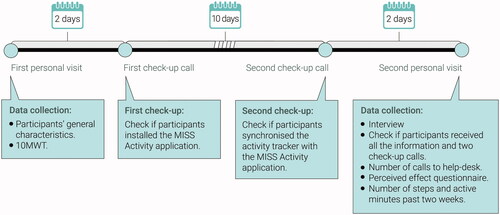
To evaluate the success of the (re)designed MISS activity, thirty participants were asked to use the MISS activity for 2 weeks. During this period, two personal visits and two check-up calls were organized ().
Participants
Participants were recruited through convenient sampling via several local associations, such as sports clubs or social initiatives for the elderly. Participants were eligible if they were 65 years or older, had a sufficient understanding of the Dutch language, and possessed a smartphone. Participants were excluded if they had an asymmetrical gait that was observed during the 10-m walking test [Citation36] or used a walking aid.
First personal visit
The first personal visit was located at a convenient location for the participant (e.g., their home). General characteristics were collected: gender, age, the highest level of education, living situation, family composition, use of technology, and their hobbies. Participants received a MISS activity, which they were asked to wear for 2 weeks, and a user manual. No further instructions about the use of the MISS activity were given. Participants were invited to call the helpdesk if they perceived any problems.
Check-up calls
Two days after the first appointment, a researcher called the participant to check if they had installed the app. The researcher pointed out again, that participants could obtain support through the helpdesk if they encountered problems. After ten days the researcher called the second time to ask if participants had synchronized the activity tracker with the application in the last 2 weeks. If not, they were asked to do so.
Second personal visit
At the end of the 2 weeks testing period, a second personal visit was scheduled during which the researcher asked whether (1) the participant had received the number of the helpdesk and the user manual, (2) whether the participant had had two check-up calls and (3) how many times the participant had called the helpdesk. The step count and active minutes per day according to the MISS activity app were recorded. Furthermore, one questionnaire was filled out in which the satisfaction with the MISS activity and the effect of their physical activity was queried (Appendix 2).
Semi-structured interviews with all participants about their experiences with the MISS activity were performed. The interview guide was based on a framework of a previous study [Citation10], with the following main categories: purchase, instruction, characteristics, correct functioning, sharing data, privacy, use of the activity tracker, and interest in feedback. The interview lasted between 15-30 min and was recorded on audio.
Data analysis
Descriptive statistics of the participants’ characteristics and questionnaires were presented as absolute numbers with medians (range). The interviews were transcribed verbatim. To analyze the interviews deductive and inductive content analysis [Citation37] was used, using NVivo (version 10). The framework [Citation10] of the interview guide was used for the deductive content analysis. Inductive coding was used when a text passage, that was relevant for the research question, did not fit the framework. Therefore, an “other” code was used to include these text passages. The first interview and every fifth interview was coded by two reviewers and an alignment session was held to fine-tune the coding. Differences in interpretation were solved by dialogue to reach consensus.
Results
(Re)design of the user-interface
Definition phase
From the 53 characteristics, 31 were prioritized as critical based on the MoSCoW model. Five of these characteristics were related to the algorithm of the activity tracker. The remaining 26 characteristics were related to the user-interface and used in de development and delivery phases (Appendix 1).
Development and delivery phase
Participants
The participants’ demographic characteristics are presented in .
Table 1. Demographics of the included participants of the develop and deliver phase.
The main features of the development and delivery phase are presented in . These findings combined resulted in the MISS activity tracker (Box 2).
Box 2. About the MISS activity tracker
The square design was worn on the pocket and secured with a clip
Algorithm outcome parameters: step count and active minutes
Users can choose whether the standing activity is included as active minutes
Feedback on battery level and progress to goal with LED lights on the activity tracker itself
Feedback is activated by shaking the activity tracker
The app shows total step count and total active minutes
The app shows a graph with the distribution of step count and active minutes during the day
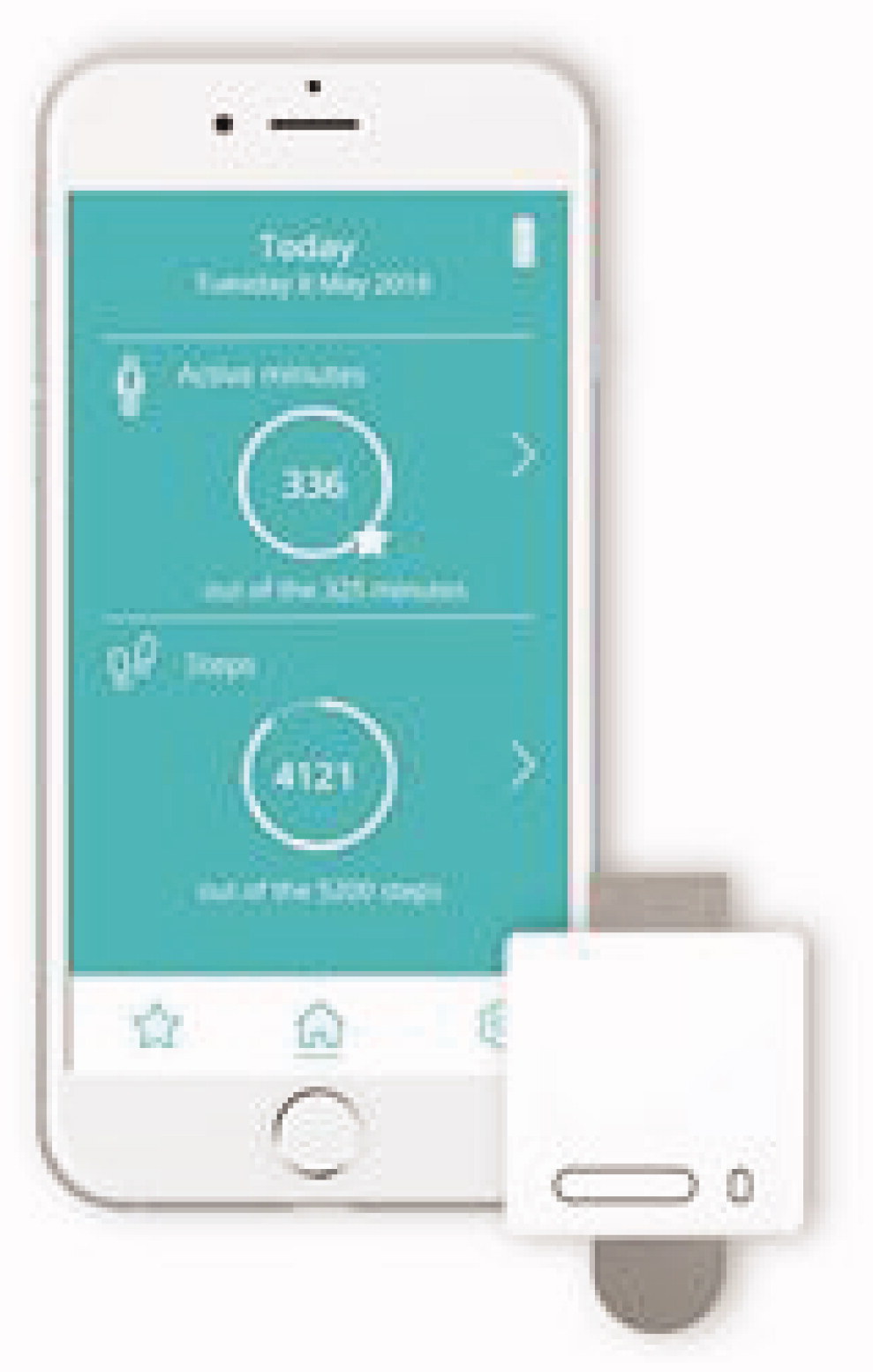
Table 2. Main finding of the development and delivery phase.
Evaluating usage and experiences in daily life
Participants
The demographic characteristics of the participants are presented in . Two participants dropped out (n = 2: participant’s smartphone was too outdated to run the MISS activity app and one due to illness).
Table 3. Demographics of the included participants during the 2-week testing period.
Interviews
All participants received the manual, as well as the number of the helpdesk, and were called twice. Of the 28 participants, 27 (96%) used the manual, and seven (24%) used it more than once. Five (16%) participants called the helpdesk. One participant asked a question about Bluetooth, one asked about the graphs, and one asked if he could swim with the MISS activity. Two participants had a question about installing the app. One participant did not use the MISS activity for four days since his step count and active minutes were zero. Fourteen participants chose to include standing as active minutes.
Eleven (42%) participants were absolutely satisfied with the MISS activity, nine (35%) were very satisfied, four (16%) were somewhat satisfied and two (7%) participants were neutral (n = 26, 2 missing participants). Eleven (42%) participants gained much more insight into their physical activity level, six (16%) gained a little more insight, and eleven (42%) did not gain any insight. One (3%) participant increased his physical activity level much, three (11%) participants increased their physical activity level a little, and 24 (86%) did not perceive any increase. One participant (3%) noticed that he divided his activities much more over the day, six (22%) participant divided their activities a little more over the day and 21 (75%) participants did not perceive any change. The results of the interviews are shown in .
Table 4. Results of the interviews presented in categories based on a previously developed framework.
Discussion
The aim of this study was twofold. The first aim was to (re)design a user-friendly interface of an existing activity tracker so that it would meet the requirements of elderly individuals. Within the (re)design process of the MOX, three aspects were (re)designed: (1) the shape and clip of the activity tracker, (2) the feedback provided on the activity tracker itself, and (3) the additional feedback provided through the app. Furthermore, a list of general design requirements that facilitate the development of technology for the elderly was developed. The iterative character of the user-centred approach enabled access to a deeper level of user understanding and thereby facilitated the development of a user-friendly activity tracker, which in turn increases the likelihood that elderly individuals will have a meaningful experience with the tracker.
The second aim of this study was to assess the use and experiences of the elderly regarding the adapted activity tracker (MISS activity) in their daily life. The results of this study show that participants found the MISS activity to be easy to use, needed limited help when installing the tracker, and thought that anyone should, in principle, be able to use it. The MISS activity was primarily used to gain insight into participants’ physical activity levels, and the data it collected was checked multiple times each day through the app. The most important distinction between this tracker and others is that elderly individuals experienced the MISS activity as easy to use; they perceived practically no imbalance between their technical knowledge and the complexity of the MISS activity. In several other studies in which elderly individuals used commercially available activity trackers, participants experienced the the trackers as technically complex and sensed that they were ill-suited not fitted for them [Citation10–16].
Limitations and strengths
This study contains several strengths and limitations that should be addressed. One strength of this study is its user-centred design. The goal of user-centred design is to create a usable system that contributes to meaningful user experience. To achieve this, (early) involvement of the end-user is indispensable [Citation47], and offers several benefits, such as a swifter acceptance of the user-interface, the capacity for users to identify problems specific to them, and the capacity for users to help define the scope of a project [Citation47]. In this study, several methods have been used – interviews, observations, and usability testing [Citation48] – to achieve a deeper understanding of the specific wishes and requirements of the elderly.
Given that a plethora of commercially available activity trackers already exists, a further strength of this study is the fact that it improved an existing activity tracker for a specific target group rather than design a new activity tracker for an overrun market. This study’s methodology and list of design requirements can easily be used as a generic structured methodology for improving further eHealth tools for target groups. Furthermore, the synopsis of key characteristics could also be applied to further eHealth and mHealth tools for the elderly.
A limitation of this study is the potential presence of selection bias, as the only elderly individuals who participated already actively used their smartphones. Of all elderly individuals in the Netherlands in 2019 (3.2 million), [Citation49], 60% use a smartphone [Citation50]. However, the elderly participating in this pilot study asserted that anyone should, in principle, be capable of using the tracker. The MISS activity is designed for elderly individuals who are interested in using eHealth to track their health, and it is, therefore, most likely the group of elderly who already actively use their smartphone.
Implications for healthcare and research
Activity trackers can be valuable to healthcare because they objectively measure physical activity throughout daily activities and provide detailed feedback. However, until now, the benefits of activity trackers had not been fully realized. A potential explanation for this could be the limited feasibility of current commercially available activity trackers for both patients and healthcare professionals [Citation10]. Additional explanations include the overwhelmingly broad spectrum of activity trackers, the lack of consumer and healthcare professional knowledge regarding which activity tracker best suits which purpose and which group, and the lack of professional knowledge regarding how to implement tracker data into healthcare treatment. This study, however, provides an overview of the features that are most relevant for the elderly, and it can be used to facilitate the process of selecting an appropriate tracker.
Further research could examine whether the MISS activity could also be used by other target groups, such as people with limited health literacy, and whether the MISS activity could be used for an extended duration. Ultimately, activity trackers and eHealth could be better implemented in healthcare [Citation51]. Activity trackers may serve several purposes in healthcare; they can be used to monitor a patient’s physical activity level, to set physical activity goals, and to evaluate the physical activity of a patient. Therefore, future studies should explore methods of using activity trackers to support healthcare professionals’ clinical reasoning, as well as their communication with their patients.
Conclusion
This study offers a structured methodology that facilitates the adaptation of an existing activity tracker. It also describes a list of design requirements based on the skills and needs of the elderly. Both can be used by other researchers and designers as a model for the adaptation and further development of eHealth tools for a target group. The MOX was successfully (re)designed to meet with the skills and needs of the elderly participating in this study. Further studies should explore methods of incorporating activity trackers into the healthcare system.
Ethical approval
This study was approved by the local ethics board (Atrium-Orbis-Zuyd Medical Ethical Committee, METCZ20180012). Written informed consent was obtained from participants. All information was handled with strict confidentiality.
Acknowledgments
We would like to thank Jos Aarts, Jolien Dabekaussen, Gaston Jamin, Erik Sauvé, and Frank Helgers for their contributions during this study.
Disclosure statement
No potential conflict of interest was reported by the author(s).
Data availability statement
The data that support the findings of this study are available from the corresponding author, upon reasonable request.
Additional information
Funding
References
- Renders C, Boots T, Visser K, et al. Smart health monitor: onderzoek naar gebruik van apps, wearables en meters. 1st ed. ’s-Hertogenbosch (The Netherlands): Multiscope; 2016.
- National Institute for Public Health and the Environment [Internet]. Bilthoven (The Nethwrlands): National Institute for Public Health and the Environment; 2017 [cited 2018 September 26]. Available from: https://www.volksgezondheidenzorg.info/sites/default/files/hoeveel_mensen_voldoen_aan_gr_beweegrichtlijnen_2017.pdf
- National Institute for Public Health and the Environment [Internet]. Bilthoven (The Netherlands): National Institute for Public Health and the Environment; 2018 [cited 2019 June 03]. Available from: https://www.rivm.nl/leefstijlmonitor/bewegen
- Warburton DER, Bredin SSD. Health benefits of physical activity: a systematic review of current systematic reviews. Curr Opin Cardiol. 2017;32(5):541–556.
- Vogel T, Brechat PH, Lepretre PM, et al. Health benefits of physical activity in older patients: a review. Int J Clin Pract. 2009;63(2):303–320.
- Costello E, Kafchinski M, Vrazel J, et al. Motivators, barriers, and beliefs regarding physical activity in an older adult population. J Geriatr Phys Ther. 2011;34(3):138–147.
- Hoogendoorn MP, de Hollander EL. Belemmeringen en drijfveren voor sport en bewegen bij ondervertegenwoordigde groepen. Bilthoven (The Netherlands): National Institute for Public Health and the Environment; 2016.
- Maher C, Ryan J, Ambrosi C, et al. Users’ experiences of wearable activity trackers: a cross-sectional study. BMC Public Health. 2017;17(1):880.
- Sullivan AN, Lachman ME. Behavior change with fitness technology in sedentary adults: a review of the evidence for increasing physical activity. Front Public Health. 2016;4:289.
- Ummels D, Beekman E, Moser A, et al. Patients’ experiences with commercially available activity trackers embedded in physiotherapy treatment: a qualitative study. Disabil Rehabil. 2019;1–9.
- O’Brien T, Troutman-Jordan M, Hathaway D, et al. Acceptability of wristband activity trackers among community dwelling older adults. Geriatr Nurs. 2015;36(2):S21–S25.
- Preusse KC, Mitzner TL, Fausset CB, et al. Older adults’ acceptance of activity trackers. J Appl Gerontol. 2017;36(2):127–155.
- Mercer K, Giangregorio L, Schneider E, et al. Acceptance of commercially available wearable activity trackers among adults aged over 50 and with chronic illness: a mixed-methods evaluation. JMIR Mhealth Uhealth. 2016;4(1):e7.
- Fausset CB, Mitzner TL, Price CE, et al. Older adults’ use of and attitudes toward activity monitoring technologies. Proc Human Factors Ergonomics Soc. 2013;57(1):1683–1687.
- Rasche P, Schäfer K, Theis S, et al. Age-related usability investigation of an activity tracker. Int J Human Factors Ergon. 2016;4(3–4):187.
- Puri A, Kim B, Nguyen O, et al. User acceptance of wrist-worn activity trackers among community-dwelling older adults: mixed method study. JMIR Mhealth Uhealth. 2017;5(11):e173.
- Maastricht Instruments [Internet]. Maastricht (The Netherlands): Maastricht Instruments BV; 2019 [cited 2019 November 01]. Available from: http://www.accelerometry.eu/mox2/
- Ummels D, Bijnens W, Aarts J, et al. The validation of a pocket worn activity tracker for step count and physical behaviour in older adults during simulated activities of daily living. 2020.
- Alley S, Schoeppe S, Guertler D, et al. Interest and preferences for using advanced physical activity tracking devices: results of a national cross-sectional survey. BMJ Open. 2016;6(7):e011243.
- Lebron J, Escalante K, Coppola J, et al. Long Island Systems, Applications and Technology Conference proceedings. Farmingdale (NY):; 2015.
- Rosenberg D, Kadokura EA, Bouldin ED, et al. AMIA Annual Symposium proceedings. Chicago (IL): AMIA; 2016.
- Shih PC, Han K, Poole ES, et al. iConference proceedings. Newport Beach (CA): IDEALS; 2015.
- Armağan K, Çiğdem E. Conference of Engineering Design proceedings. Milano (Italy): Politecnico di Milano, School of Design; 2015.
- Rabin C, Bock B. Desired features of smartphone applications promoting physical activity. Telemed J E Health. 2011;17(10):801–803.
- Verwey R. Get moving! Self-management support using mobile technology [disseratation]. Maastricht (The Netherlands): Maastricht University; 2015.
- Karapanos E, Gouveia R, Hassenzahl M, et al. Wellbeing in the making: peoples’ experiences with wearable activity trackers. Psychol Well Being. 2016;6:4.
- van der Weegen S, Verwey R, Spreeuwenberg M, et al. The development of a mobile monitoring and feedback tool to stimulate physical activity of people with a chronic disease in primary care: a user-centered design. JMIR Mhealth Uhealth. 2013;1(2):e8.
- Project Catalyst [Internet]. Washington (DC): AARP Research; 2016 [cited 2020 June 18]. Available from: https://www.aarp.org/content/dam/aarp/home-and-family/personal-technology/2015-07/innovation-50-project-catalyst-tracker-study-AARP.pdf
- Tedesco S, Barton J, O’Flynn B. A review of activity trackers for senior citizens: research perspectives, commercial landscape and the role of the insurance industry. Sensors. 2017;17(6). DOI:10.3390/s17061277
- Wang JB, Cadmus-Bertram LA, Natarajan L, et al. Wearable sensor/device (Fitbit One) and SMS text-messaging prompts to increase physical activity in overweight and obese adults: a randomized controlled trial. Telemed J E Health. 2015;21(10):782–792.
- Schlomann A. A case study on older adults’ long-term use of an activity tracker. Gerontechnology. 2017;16(2):115–124.
- Fritz T, Huang EM, Murphy GC, et al. CHI proceedings. Vancouver (Canada): ACM; 2014.
- Design Council [Internet]. London (UK): British Design Council; 2015 [2020 June 18]. Available from: https://www.designcouncil.org.uk/news-opinion/what-framework-innovation-design-councils-evolved-double-diamond
- Clegg D, Barker R. Case method fast-track: a RAD approach. Boston (MA): Addison-Wesley; 2004.
- Maastricht Instruments [Internet]. Maastricht (The Netherlands): Maastricht Instruments BV; 2019 [2019 February 22]. Available from: https://www.accelerometry.eu/miss-activity/
- Collen FM, Wade DT, Bradshaw CM. Mobility after stroke: reliability of measures of impairment and disability. Int Disabil Stud. 1990;12(1):6–9.
- Elo S, Kyngas H. The qualitative content analysis process. J Adv Nurs. 2008;62(1):107–115.
- Compendium of physical activities [Internet]. Tempe (AZ): Healthy Lifestyles Research Center, College of Nursing & Health Innovation, Arizona State University; 2011 [cited 2020 October 26]. Available from: https://sites.google.com/site/compendiumofphysicalactivities/Activity-Categories/home-activity.
- Health Council of the Netherlands [Internet]. Den Haag (The Netherlands): Health Council of the Netherlands; 2017 [cited 2018 January 20]. Available from: https://www.gezondheidsraad.nl/sites/default/files/grpublication/beweegrichtlijnen_2017.pdf
- Pharmacy [Internet]. Los Angeles (CA): The Noun Project; 2020 [cited 2020 June 18]. Available from: https://thenounproject.com/search/?q=pharmacy&i=399860.
- Help [Internet]. Los Angeles (CA): The Noun Project; 2020 [cited 2020 June 18]. Available from: https://thenounproject.com/search/?q=help&i=2854287
- App [Internet]. Los Angeles (CA): The Noun Project; [cited 2020 June 18]. Available from: https://thenounproject.com/search/?q=app&i=1295151
- Mobile Settings [Internet]. Los Angeles (CA): The Noun Project; [cited 2020 June 18]. Available from: https://thenounproject.com/search/?q=mobile%20settings&i=1018566
- Privacy [Internet]. Los Angeles (CA): The Noun Project; [cited 2020 June 18]. Available from: https://thenounproject.com/search/?q=privacy&i=2804339
- Graph [Internet]. Los Angeles (CA): The Noun Project; [cited 2020 June 18]. Available from: https://thenounproject.com/search/?q=graphs&i=2243582
- Walking [Internte]. Los Angeles (CA): The Noun Project; [cited 2020 June 18]. Available from: https://thenounproject.com/search/?q=walking&i=95239
- Kujala S. User involvement: a review of the benefits and challenges. Behav Inform Technol. 2003;22(1):1–16.
- Abras C, Maloney-Krichmar D, Preece J. Encyclopedia of human-computer interaction. Thousand Oaks (CA): Sage Publications; 2004.
- National Institute for Public Health and the Environment [Internet]. Bilthoven (The Netherlands): National Institute for Public Health and the Environment; 2019 [cited 2019 June 21]. Available from: https://www.volksgezondheidenzorg.info/onderwerp/bevolking/cijfers-context/vergrijzing#node-totaal-aantal-ouderen
- Statistics Netherlands [Internet]. Heerlen (The Netherlands): Statistics Netherland; 2016 [cited 2020 June 18]. Available from: https://www.cbs.nl/nl-nl/nieuws/2016/52/75-plussers-sterkst-groeiende-groep-internetters
- Wouters M, Huygens M, Voogdt H, et al. E-health monitor: samen aan zet!. Utrecht (The Netherlands): Netherlands Institute for Health Services Research; 2019.
Appendix 1
Appendix 1. Important characteristics to create a meaningful user-interface for elderly.
Appendix 2
Appendix 2. Questionnaire about the perceived effect of the MISS activity
1. Overall, to what degree did you gain insight into your physical activity level?
1.1. ◯ Very much more insight
1.2. ◯ Much more insight
1.3. ◯ A little more insight
1.4. ◯ No change
1.5. ◯ A little less insight
1.6. ◯ Much less insight
1.7. ◯ Very much less insight
2. To what degree did your physical activity level change?
2.1. ◯ Very much more physical activity
2.2. ◯ Much more physical activity
2.3. ◯ A little more physical activity
2.4. ◯ No change
2.5. ◯ A little less physical activity
2.6. ◯ Much less physical activity
2.7. ◯ Very much less physical activity
3. To what degree was your physical activity more divided during the day?
3.1. ◯ Very much more divided
3.2. ◯ Much more divided
3.3. ◯ A little more divided
3.4. ◯ No change
3.5. ◯ A little less divided
3.6. ◯ Much less divided
3.7. ◯ Very much less divided

